主谓一致的常见规则[下学期]
图片预览
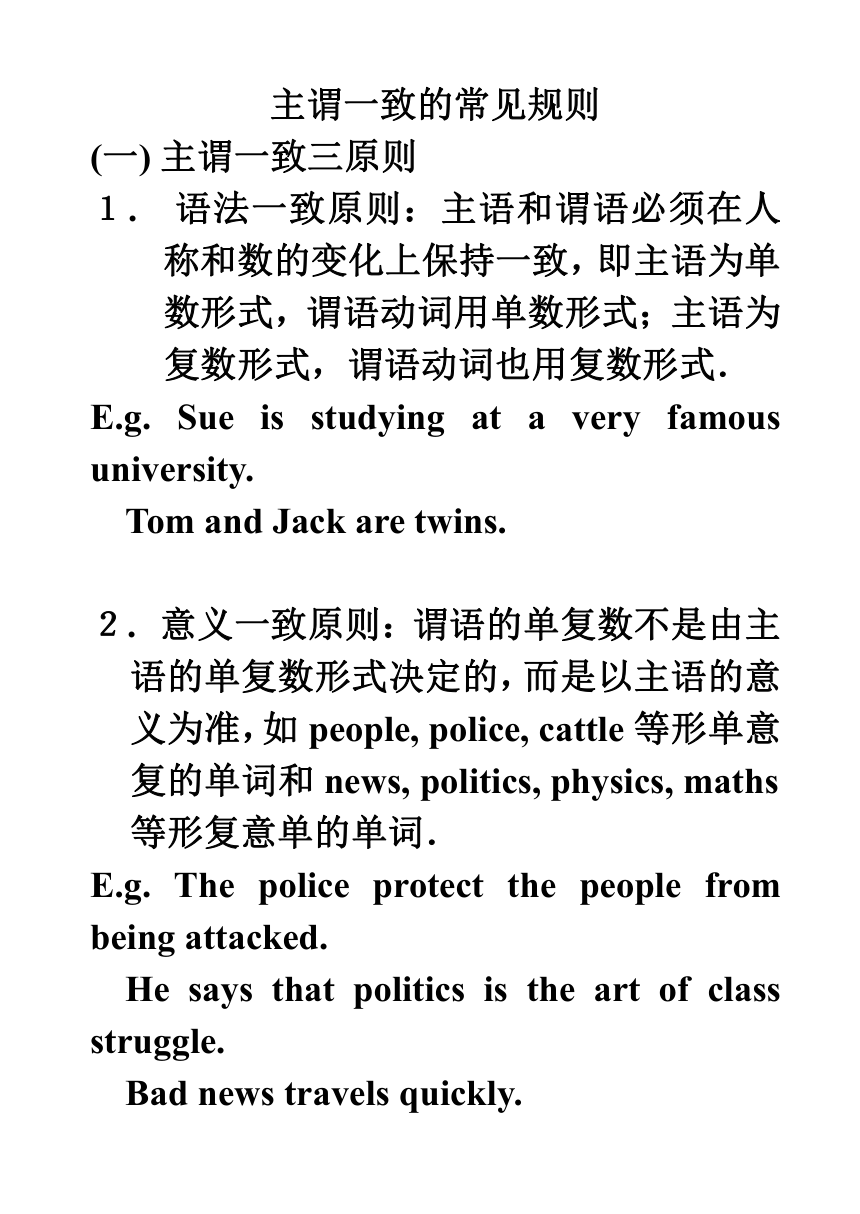
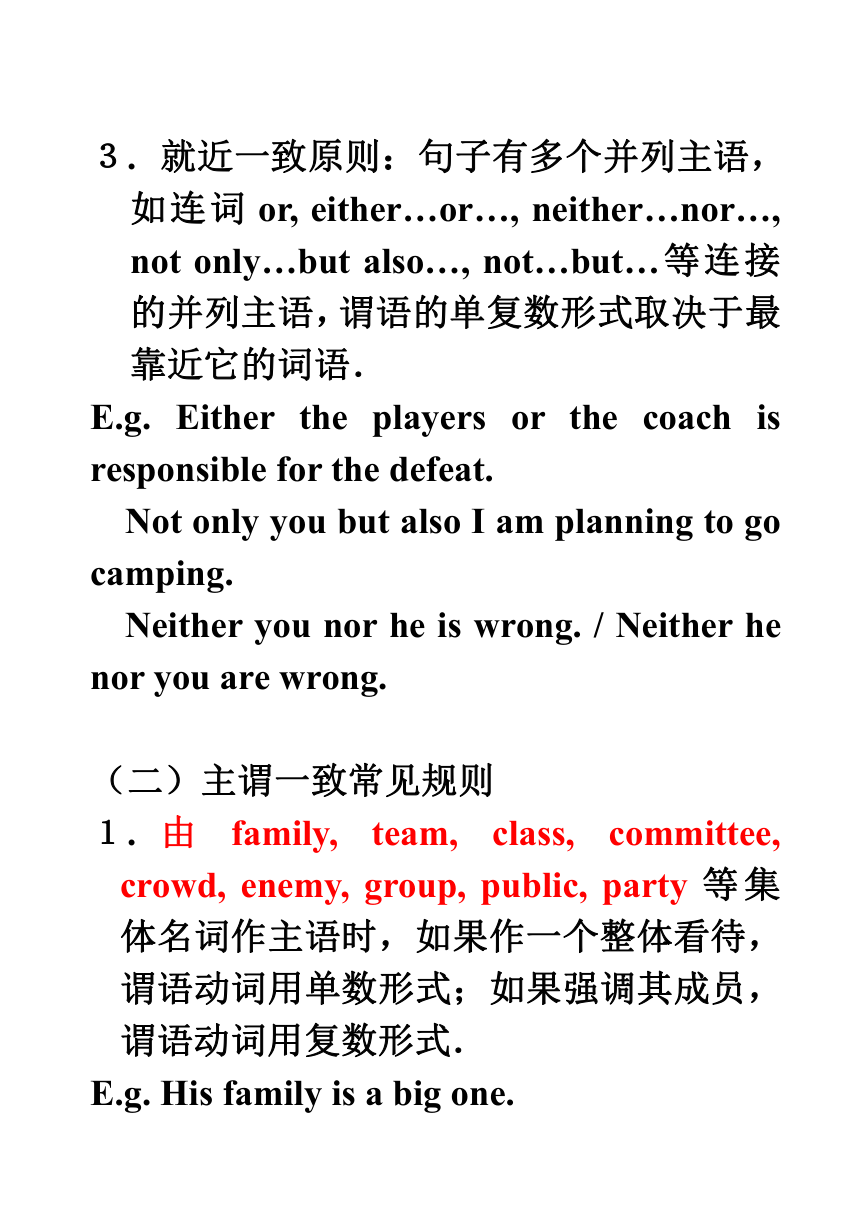
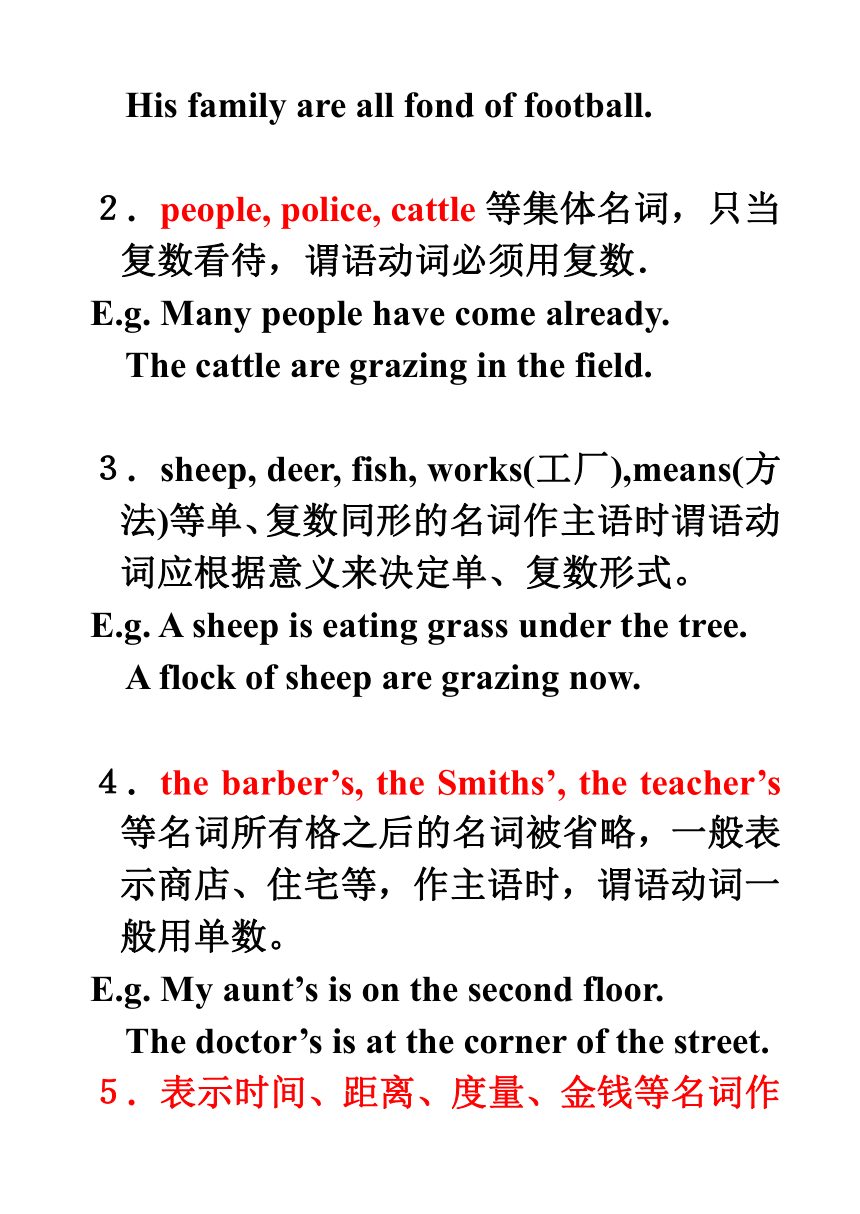
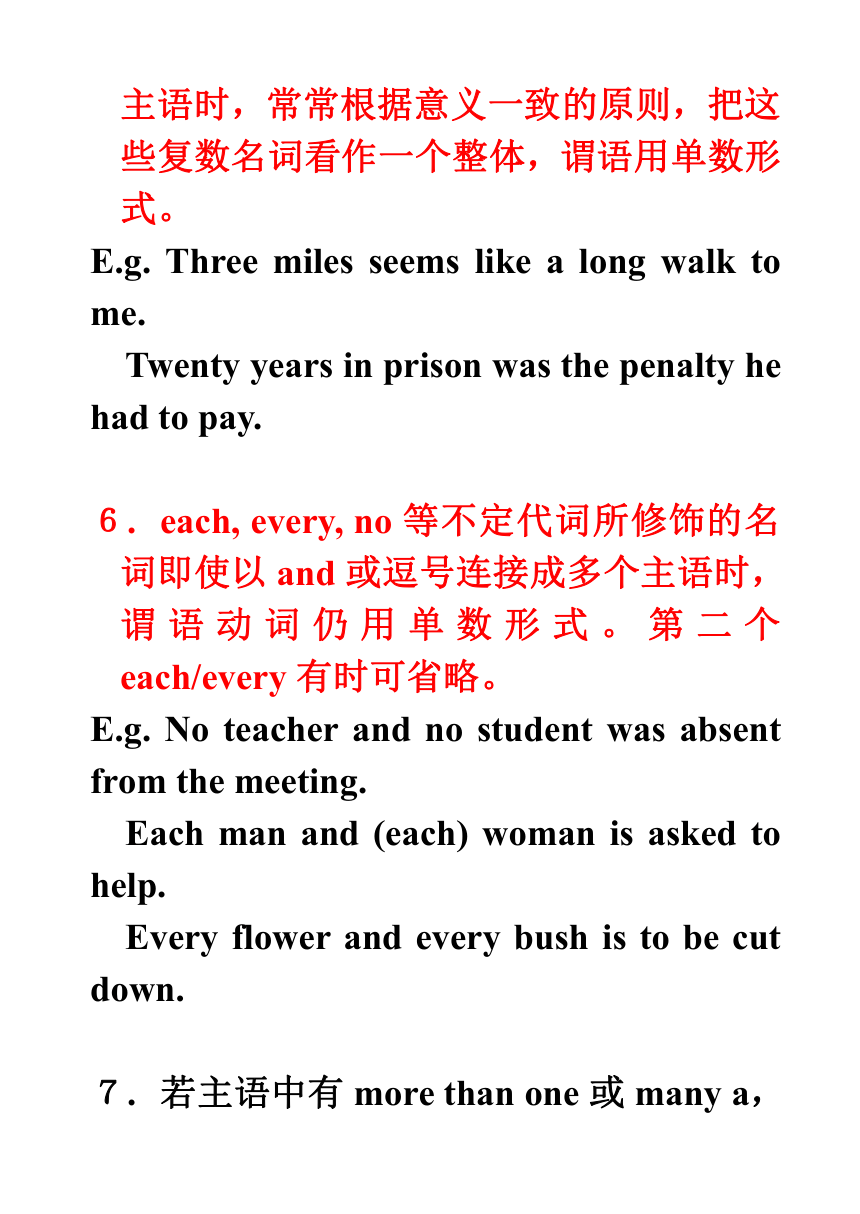
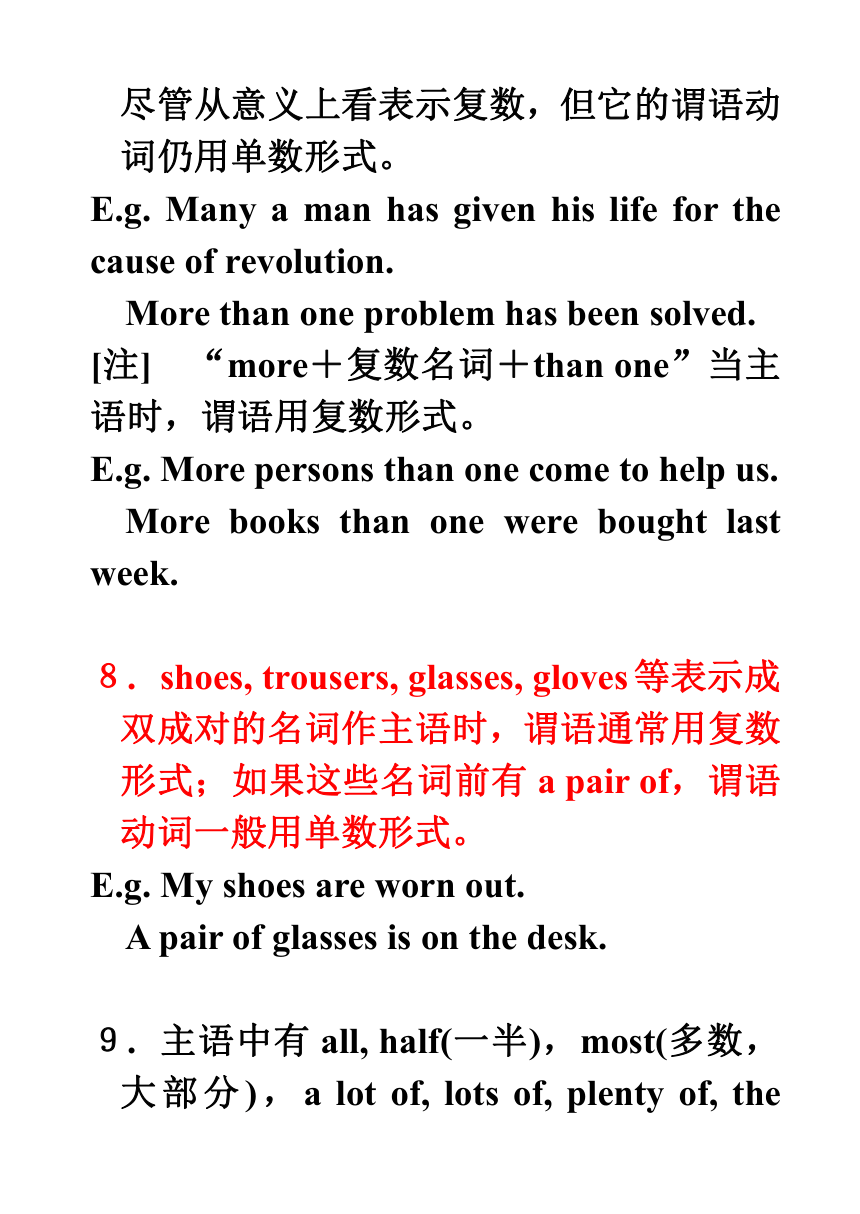
文档简介
主谓一致的常见规则
(1) 主谓一致三原则
1. 语法一致原则:主语和谓语必须在人称和数的变化上保持一致,即主语为单数形式,谓语动词用单数形式;主语为复数形式,谓语动词也用复数形式.
E.g. Sue is studying at a very famous university.
Tom and Jack are twins.
2. 意义一致原则:谓语的单复数不是由主语的单复数形式决定的,而是以主语的意义为准,如people, police, cattle等形单意复的单词和news, politics, physics, maths等形复意单的单词.
E.g. The police protect the people from being attacked.
He says that politics is the art of class struggle.
Bad news travels quickly.
3. 就近一致原则:句子有多个并列主语,如连词or, either…or…, neither…nor…, not only…but also…, not…but…等连接的并列主语,谓语的单复数形式取决于最靠近它的词语.
E.g. Either the players or the coach is responsible for the defeat.
Not only you but also I am planning to go camping.
Neither you nor he is wrong. / Neither he nor you are wrong.
(二)主谓一致常见规则
1. 由family, team, class, committee, crowd, enemy, group, public, party等集体名词作主语时,如果作一个整体看待,谓语动词用单数形式;如果强调其成员,谓语动词用复数形式.
E.g. His family is a big one.
His family are all fond of football.
2. people, police, cattle等集体名词,只当复数看待,谓语动词必须用复数.
E.g. Many people have come already.
The cattle are grazing in the field.
3. sheep, deer, fish, works(工厂),means(方法)等单、复数同形的名词作主语时谓语动词应根据意义来决定单、复数形式。
E.g. A sheep is eating grass under the tree.
A flock of sheep are grazing now.
4. the barber’s, the Smiths’, the teacher’s 等名词所有格之后的名词被省略,一般表示商店、住宅等,作主语时,谓语动词一般用单数。
E.g. My aunt’s is on the second floor.
The doctor’s is at the corner of the street.
5. 表示时间、距离、度量、金钱等名词作主语时,常常根据意义一致的原则,把这些复数名词看作一个整体,谓语用单数形式。
E.g. Three miles seems like a long walk to me.
Twenty years in prison was the penalty he had to pay.
6. each, every, no等不定代词所修饰的名词即使以and或逗号连接成多个主语时,谓语动词仍用单数形式。第二个each/every有时可省略。
E.g. No teacher and no student was absent from the meeting.
Each man and (each) woman is asked to help.
Every flower and every bush is to be cut down.
7. 若主语中有more than one或many a,尽管从意义上看表示复数,但它的谓语动词仍用单数形式。
E.g. Many a man has given his life for the cause of revolution.
More than one problem has been solved.
[注] “more+复数名词+than one”当主语时,谓语用复数形式。
E.g. More persons than one come to help us.
More books than one were bought last week.
8. shoes, trousers, glasses, gloves等表示成双成对的名词作主语时,谓语通常用复数形式;如果这些名词前有a pair of,谓语动词一般用单数形式。
E.g. My shoes are worn out.
A pair of glasses is on the desk.
9. 主语中有all, half(一半),most(多数,大部分),a lot of, lots of, plenty of, the rest(余下的), the remainder(剩余的)等以及“分数或百分数+名词”用于主语时,其单、复数取决于连用的名词,名词为单数时,谓语也用单数;名词用复数时,谓语也用复数。
E.g. Half of the students are boys.
The rest of the bicycles are on sale today.
Most of the students are from Nanjing.
Three-quarters of the city was destroyed in the war.
Two-thirds of the people present are against the plan.
It is said that 35 percent of the doctors are women.
10. and连接并列主语,谓语动词通常用复数形式,但并列主语如果指同一个人、同一事物或同一概念时,谓语动词用单数形式,这时and后面的名词没有冠词。
E.g. Baseball and swimming are usually summer sports.
Your friend and adviser has agreed to lend me his money.
[注] 并列主语指经常联系在一起的东西,表示一个概念时,动词用单数。
E.g. Whisky and soda is always my favorite drink.
War and peace is a constant theme in history.
11. 当主语后面有as well as, no less than, along with, with, together with, but, except, besides, including, rather than(不是…而是…)等引导的词组时,其谓语动词的单、复数按主语的单、复数决定。
E.g. Some of the workers, as well as the manager, were working during the holidays.
Jean, rather than her roommates, is to blame.
No one except two servants was late for the dinner.
12. 表示数量的one and a half后跟复数形式的名词,但是当它作主语时,谓语动词通常用单数形式。
E.g. Only one and a half apples is left on the plate.
[注]“one or two+复数名词”作主语,谓语动词用复数形式。
E.g. One or two places have been visited.
13. “the+形容词/过去分词或动词的ing形式”结构表示一类人或事物,作主语,谓语通常用复数。
E.g. The sick have been cured and the lost have been found.
The wounded were well looked after in the hospital.
14. what引导主语从句时,主句谓语动词通常用单数,但所指的具体内容是复数意义时,主句的谓语动词一般用复数形式。
E.g. What we need is more help.
What they want are promises. (表语promises是复数,故用are.)
15. 以数词为中心词构成主语时,如把数目看为一个整体时,谓语用单数。
E.g. Fifteen minus five leaves ten.
Eighteen plus five is twenty-three.
Five times eight is forty.
Fifteen divided by three is five.
16. “one + in/out of/of +名词”作主语时,谓语用单数形式。
E.g. One in/of/out of twenty was badly damaged.
17. “one of + 复数名词 + who/that/which”引导的定语从句中,关系代词who/that/which的先行词是靠近它的复数名词而不是one,因此定语从句中的动词应为复数。
E.g. Mary is one of those people who keep pets.
This is one of the most interesting questions that have been asked.
[注] “the only one of +复数名词+ who/that/which”引导的定语从句中,关系代词的先行词为one,谓语用单数。
E.g. Sarah was the only one of the youngest girls who plays in the band.
18. none作主语时, 若none指不可数名词,谓语用单数;none指可数名词时,谓语用复数。
E.g. None of the water is left.
None has/have turned up yet. (用has时,强调一个也没来;用have时,指本该很多人来,但都没有来。)
19. there引导的存在句的动词的形式和靠近的名词保持一致。
E.g. There were some daisies and a red rose in the vase.
There were not only his children but also his wife to consider.
There is food and drink enough for everyone.
There is a dictionary and some other books on the table.
20. Chinese, Japanese, English, French等当主语表示语言时,动词用单数;表示某国人时,动词用复数,这时与冠词the连用。
E.g. Chinese is difficult to learn.
The Chinese are very hard-working.
21. 单个的动词的ing形式或不定式作主语时,谓语动词用单数形式。
E.g. To listen to music is my greatest pleasure.
Taking care of the sick is her job.
[注]若两个及以上动词的ing形式或不定式作并列主语时,谓语动词一般用复数形式。
E.g. When to have the meeting and who to hold the meeting are not decided yet.
Going camping and rocket climbing are her favorite sports.
单项选择
1. Nobody but Jane _____ the street.
A. knows B. know C. have known D. is known
2. Three-fourths of the surface of the earth ______ sea.
A. is B. are C. were D. has been
3. All but one _____ here just now.
A. is B. was C. has been D. were
4. His Selected Poems _____ first published in 1965.
A. is B. was C. has been D. were
5. When and where to build the factory ______ yet.
A. is not decided B. are not decided C. has not decided D. have not decided
6. A fork and knife ______ on the table.
A. is B. are C. has been D. have been
7. Where _____ dirt, there are flies.
A. is B. are C. has been D. have been
8. Each soldier and each sailor _____ a rifle.
A. are given B. was given C. being given D. were given
9. My clothes _____ made to order.
A. is B. are C. has D. have
10. The old _____ taken good care of in our country.
A. is B. has C. are D. have
11. Light and heat _____ often sent out together with heavy smoke.
A. is B. was C. are D. being
12. There _____ a needle and thread. You can do the sewing and mending yourself.
A. have B. has C. is D. are
13. Half of the fruit ______ gone bad.
A. is B. are C. has D. have
14. E-mail, as well as telephone, ______ an important part in daily communication.
A. is playing B. have played C. are playing D. play
15. No chair and no desk _____ permitted to be taken away from the reading room.
A. are B. were C. is D. has
16. The iron and steel industry _______ an important part in our national economy.
A. plays B. play C. are playing D. have played
17. Alice, together with two boys, _____ for having broken the rule.
A. was punished B. punished C. were punished D. being punished
18. Twenty days ______ a long time to them.
A, seem B. seems C. looks D. look
19. Many a man _____ come to help us.
A. have B. has C. is D. are
20. The rich ______ not always happy.
A. are B. is c. has D. have
Answers:
1-5 AADBA
6-10 AABBC
11-15 CCCAC
16-20 AABBA
(1) 主谓一致三原则
1. 语法一致原则:主语和谓语必须在人称和数的变化上保持一致,即主语为单数形式,谓语动词用单数形式;主语为复数形式,谓语动词也用复数形式.
E.g. Sue is studying at a very famous university.
Tom and Jack are twins.
2. 意义一致原则:谓语的单复数不是由主语的单复数形式决定的,而是以主语的意义为准,如people, police, cattle等形单意复的单词和news, politics, physics, maths等形复意单的单词.
E.g. The police protect the people from being attacked.
He says that politics is the art of class struggle.
Bad news travels quickly.
3. 就近一致原则:句子有多个并列主语,如连词or, either…or…, neither…nor…, not only…but also…, not…but…等连接的并列主语,谓语的单复数形式取决于最靠近它的词语.
E.g. Either the players or the coach is responsible for the defeat.
Not only you but also I am planning to go camping.
Neither you nor he is wrong. / Neither he nor you are wrong.
(二)主谓一致常见规则
1. 由family, team, class, committee, crowd, enemy, group, public, party等集体名词作主语时,如果作一个整体看待,谓语动词用单数形式;如果强调其成员,谓语动词用复数形式.
E.g. His family is a big one.
His family are all fond of football.
2. people, police, cattle等集体名词,只当复数看待,谓语动词必须用复数.
E.g. Many people have come already.
The cattle are grazing in the field.
3. sheep, deer, fish, works(工厂),means(方法)等单、复数同形的名词作主语时谓语动词应根据意义来决定单、复数形式。
E.g. A sheep is eating grass under the tree.
A flock of sheep are grazing now.
4. the barber’s, the Smiths’, the teacher’s 等名词所有格之后的名词被省略,一般表示商店、住宅等,作主语时,谓语动词一般用单数。
E.g. My aunt’s is on the second floor.
The doctor’s is at the corner of the street.
5. 表示时间、距离、度量、金钱等名词作主语时,常常根据意义一致的原则,把这些复数名词看作一个整体,谓语用单数形式。
E.g. Three miles seems like a long walk to me.
Twenty years in prison was the penalty he had to pay.
6. each, every, no等不定代词所修饰的名词即使以and或逗号连接成多个主语时,谓语动词仍用单数形式。第二个each/every有时可省略。
E.g. No teacher and no student was absent from the meeting.
Each man and (each) woman is asked to help.
Every flower and every bush is to be cut down.
7. 若主语中有more than one或many a,尽管从意义上看表示复数,但它的谓语动词仍用单数形式。
E.g. Many a man has given his life for the cause of revolution.
More than one problem has been solved.
[注] “more+复数名词+than one”当主语时,谓语用复数形式。
E.g. More persons than one come to help us.
More books than one were bought last week.
8. shoes, trousers, glasses, gloves等表示成双成对的名词作主语时,谓语通常用复数形式;如果这些名词前有a pair of,谓语动词一般用单数形式。
E.g. My shoes are worn out.
A pair of glasses is on the desk.
9. 主语中有all, half(一半),most(多数,大部分),a lot of, lots of, plenty of, the rest(余下的), the remainder(剩余的)等以及“分数或百分数+名词”用于主语时,其单、复数取决于连用的名词,名词为单数时,谓语也用单数;名词用复数时,谓语也用复数。
E.g. Half of the students are boys.
The rest of the bicycles are on sale today.
Most of the students are from Nanjing.
Three-quarters of the city was destroyed in the war.
Two-thirds of the people present are against the plan.
It is said that 35 percent of the doctors are women.
10. and连接并列主语,谓语动词通常用复数形式,但并列主语如果指同一个人、同一事物或同一概念时,谓语动词用单数形式,这时and后面的名词没有冠词。
E.g. Baseball and swimming are usually summer sports.
Your friend and adviser has agreed to lend me his money.
[注] 并列主语指经常联系在一起的东西,表示一个概念时,动词用单数。
E.g. Whisky and soda is always my favorite drink.
War and peace is a constant theme in history.
11. 当主语后面有as well as, no less than, along with, with, together with, but, except, besides, including, rather than(不是…而是…)等引导的词组时,其谓语动词的单、复数按主语的单、复数决定。
E.g. Some of the workers, as well as the manager, were working during the holidays.
Jean, rather than her roommates, is to blame.
No one except two servants was late for the dinner.
12. 表示数量的one and a half后跟复数形式的名词,但是当它作主语时,谓语动词通常用单数形式。
E.g. Only one and a half apples is left on the plate.
[注]“one or two+复数名词”作主语,谓语动词用复数形式。
E.g. One or two places have been visited.
13. “the+形容词/过去分词或动词的ing形式”结构表示一类人或事物,作主语,谓语通常用复数。
E.g. The sick have been cured and the lost have been found.
The wounded were well looked after in the hospital.
14. what引导主语从句时,主句谓语动词通常用单数,但所指的具体内容是复数意义时,主句的谓语动词一般用复数形式。
E.g. What we need is more help.
What they want are promises. (表语promises是复数,故用are.)
15. 以数词为中心词构成主语时,如把数目看为一个整体时,谓语用单数。
E.g. Fifteen minus five leaves ten.
Eighteen plus five is twenty-three.
Five times eight is forty.
Fifteen divided by three is five.
16. “one + in/out of/of +名词”作主语时,谓语用单数形式。
E.g. One in/of/out of twenty was badly damaged.
17. “one of + 复数名词 + who/that/which”引导的定语从句中,关系代词who/that/which的先行词是靠近它的复数名词而不是one,因此定语从句中的动词应为复数。
E.g. Mary is one of those people who keep pets.
This is one of the most interesting questions that have been asked.
[注] “the only one of +复数名词+ who/that/which”引导的定语从句中,关系代词的先行词为one,谓语用单数。
E.g. Sarah was the only one of the youngest girls who plays in the band.
18. none作主语时, 若none指不可数名词,谓语用单数;none指可数名词时,谓语用复数。
E.g. None of the water is left.
None has/have turned up yet. (用has时,强调一个也没来;用have时,指本该很多人来,但都没有来。)
19. there引导的存在句的动词的形式和靠近的名词保持一致。
E.g. There were some daisies and a red rose in the vase.
There were not only his children but also his wife to consider.
There is food and drink enough for everyone.
There is a dictionary and some other books on the table.
20. Chinese, Japanese, English, French等当主语表示语言时,动词用单数;表示某国人时,动词用复数,这时与冠词the连用。
E.g. Chinese is difficult to learn.
The Chinese are very hard-working.
21. 单个的动词的ing形式或不定式作主语时,谓语动词用单数形式。
E.g. To listen to music is my greatest pleasure.
Taking care of the sick is her job.
[注]若两个及以上动词的ing形式或不定式作并列主语时,谓语动词一般用复数形式。
E.g. When to have the meeting and who to hold the meeting are not decided yet.
Going camping and rocket climbing are her favorite sports.
单项选择
1. Nobody but Jane _____ the street.
A. knows B. know C. have known D. is known
2. Three-fourths of the surface of the earth ______ sea.
A. is B. are C. were D. has been
3. All but one _____ here just now.
A. is B. was C. has been D. were
4. His Selected Poems _____ first published in 1965.
A. is B. was C. has been D. were
5. When and where to build the factory ______ yet.
A. is not decided B. are not decided C. has not decided D. have not decided
6. A fork and knife ______ on the table.
A. is B. are C. has been D. have been
7. Where _____ dirt, there are flies.
A. is B. are C. has been D. have been
8. Each soldier and each sailor _____ a rifle.
A. are given B. was given C. being given D. were given
9. My clothes _____ made to order.
A. is B. are C. has D. have
10. The old _____ taken good care of in our country.
A. is B. has C. are D. have
11. Light and heat _____ often sent out together with heavy smoke.
A. is B. was C. are D. being
12. There _____ a needle and thread. You can do the sewing and mending yourself.
A. have B. has C. is D. are
13. Half of the fruit ______ gone bad.
A. is B. are C. has D. have
14. E-mail, as well as telephone, ______ an important part in daily communication.
A. is playing B. have played C. are playing D. play
15. No chair and no desk _____ permitted to be taken away from the reading room.
A. are B. were C. is D. has
16. The iron and steel industry _______ an important part in our national economy.
A. plays B. play C. are playing D. have played
17. Alice, together with two boys, _____ for having broken the rule.
A. was punished B. punished C. were punished D. being punished
18. Twenty days ______ a long time to them.
A, seem B. seems C. looks D. look
19. Many a man _____ come to help us.
A. have B. has C. is D. are
20. The rich ______ not always happy.
A. are B. is c. has D. have
Answers:
1-5 AADBA
6-10 AABBC
11-15 CCCAC
16-20 AABBA
